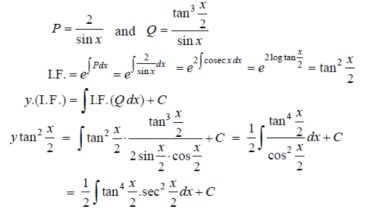
S1) We can write the equation as below-
Here M = So that-
The equation is exact and its solution will be-
Or
|

S2) We can write the given equation as-
Here, M =
Multiply equation (1) by
This is an exact differential equation-
|

S3) Here given,
M = 2y and N = 2x log x - xy Then-
Here,
Then,
Now multiplying equation (1) by 1/x, we get-
|

S4) We can write the equation as below-
Now comparing with-
We get- a = b = 1, m = n = 1, a’ = b’ = 2, m’ = 2, n’ = -1 I.F. = Where-
On solving we get- h = k = -3
Multiply the equation by
|
It is an exact equation. So that the solution is-
|

S5) We can write the given equation as-
So that- I.F. = The solution of equation (1) will be-
Or
Or
Or
|
 )
)S6) here we have, sin x
Now,
Put tan
Which is the required solution. |

S7) We can write the equation as-
On dividing by
Put Equation (1) becomes,
Here,
Therefore the solution is-
Or
Now put
Integrate by parts-
Or
|

S8) here given-
We can re-write this as-
Which is a linear differential equation-
The solution will be-
Put
|

S9) Here we have-
Now differentiate it with respect to x, we get-
Or
This is the Leibnitz’s linear equation in x and p, here
Then the solution of (2) is-
Or
Or
Put this value of x in (1), we get
|

S10) Put So that-
Then the given equation becomes-
Or
Or
Which is the Clairaut’s form. Its solution is-
i.e.
|



















































































